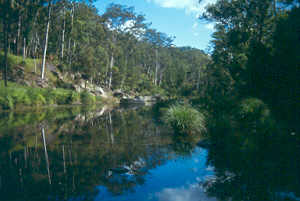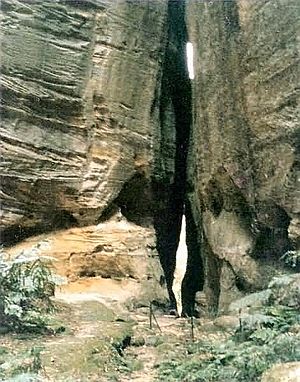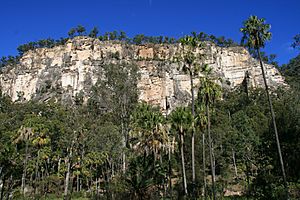Carnarvon Gorge facts for kids
Carnarvon Gorge is an amazing natural wonder in Central Queensland, Australia. It's about 593 kilometers northwest of Brisbane. This huge gorge was mostly carved out by water over millions of years. It's around 30 kilometers long and 600 meters deep at its entrance. Carnarvon Gorge is part of the larger Carnarvon National Park and is the most popular spot there because it's easy to get to and has so much to see. The closest towns are Injune and Rolleston.
In 2009, during the Q150 celebrations, Carnarvon Gorge was named one of the Q150 Icons of Queensland. It was recognized as a top "Natural attraction" for its beauty and importance.
Contents
History of Carnarvon Gorge
Some researchers believe that Aboriginal people did not live in the gorge all the time. This might have been for safety reasons or because they considered the gorge a very special, sacred place. Their Dreamtime stories tell of the Rainbow Serpent creating the gorges. This serpent is said to still live in the permanent waterholes today.
European Exploration and Settlement
Ludwig Leichhardt was the first European explorer to come close to the area in 1844. He noted the mountain ranges during his trip to Port Essington. Two years later, Thomas Mitchell explored to the west of Carnarvon Gorge. Mitchell named the Carnarvon Range, possibly after Henry Herbert, the 3rd Earl of Carnarvon.
Reports of good land and water brought settlers to the area. This led to difficult times and conflicts between the settlers and Aboriginal people. By the late 1870s, the settlers had taken control. Many local Aboriginal people sought help on properties run by people who understood their struggles. Later, many were sadly forced to leave their homelands. They were moved to government or church-run reserves and missions. This forced removal caused a lot of cultural damage.
From Farming to National Park
Farming cattle and growing crops is still an important industry around Carnarvon Gorge. However, since 1932, when the gorge became a National Park, these activities are no longer allowed inside it. In 1974, the Ka Ka Mundi area, which had been used for grazing for about a century, also became part of the park. Instead of cattle grazing, tourism has grown. More than 70,000 visitors come to Carnarvon Gorge each year to explore its wonders.
Exploring Carnarvon Gorge
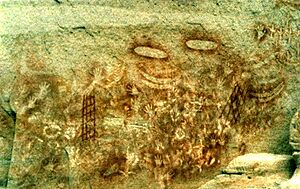
The first ten kilometers of Carnarvon Gorge offer many amazing sights. Visitors can see important Indigenous cultural sites and ancient rock art. There are also narrow sandstone canyons, tall sandstone cliffs, and flat areas with basalt rocks on top. You can also find special rainforest plants here.
Walking Tracks and Special Sites
A main 10-kilometer track leads into Carnarvon Gorge. From this track, you can take detours to special spots like the Art Gallery, Big Bend, Wards Canyon, Cathedral Cave, the Amphitheatre, and the Moss Garden. Near the entrance of Carnarvon Gorge, there are five more places to visit: Boolimba Bluff, the Nature Trail, the Rockpool, Mickey Creek Gorge, and Baloon Cave (which was closed in December 2018 due to bushfire damage). For experienced hikers, there are also remote tracks like the Ranch, the Devil's Signpost, and Battleship Spur.
Rocks and Landscapes of the Gorge
Carnarvon Gorge is located in the Central Queensland Sandstone Belt. Its landscapes have been shaped mainly by water erosion. Over the last 27 million years, Carnarvon Creek has carved through 600 meters of rock. This has revealed rocks from three major periods of Queensland's geological past. These include two sedimentary basins, the Bowen Basin and the Surat Basin, and the Buckland Volcanic Province.
The youngest rocks are the basalt rocks from the Buckland Volcanic Province. They were formed between 35 and 27 million years ago and can be up to 300 meters thick. This basalt layer is found on top of the high country on both sides of the Gorge. It protects the land from erosion and creates different types of soil. Large boulders from this basalt layer are common in the Gorge's waterways. They resist water erosion better than the softer sedimentary rocks.
The most visible rocks in the Gorge belong to the Surat Basin. This basin holds most of Queensland's gas and oil, as well as a lot of groundwater. The Surat Basin is part of the Great Artesian Basin, which creates many springs within the Gorge. The oldest part of the Surat Basin is the porous Precipice Sandstone. This sandstone forms the Gorge's amazing cliffs. It is also a main area where water enters the Great Artesian Basin, making it an important replenishment zone.
Below the Precipice Sandstone, the Gorge's floor is made of the Moolayember Formation, which is the top layer of the Bowen Basin. This layer doesn't let water pass through easily. This means that water from Carnarvon Gorge's springs stays close to or above the surface. This is very important for the water supply in the Gorge's ecosystems. Carnarvon Creek is a very reliable source of water. Its flow has only stopped twice since records began. During droughts, the Gorge becomes an oasis, supporting life that has disappeared from the drier areas around it.
Each type of rock in the Gorge wears away differently. This variety of soils and landforms helps explain why Carnarvon Gorge supports such a wide range of plant and animal life.
Climate in the Gorge
The climate inside Carnarvon Gorge is quite different from the flatter areas around it. The Gorge gets more rain, about 1,000 millimeters each year. Temperatures on the Gorge floor are also more moderate. The lowest temperature recorded inside the Gorge is -2°C. However, just 5 kilometers from its entrance, temperatures can drop below -5°C.
In July, the average temperature ranges from 6.3°C to 20.9°C. In January, the average range is 20.5°C to 35.5°C. February is usually the wettest month, and August is the driest. It's important to remember that Australia's climate can be very unpredictable. For example, between October 2007 and February 2008, Carnarvon Gorge received 1,400 millimeters of rain. This was 140% of its average annual rainfall!
Plants of Carnarvon Gorge

Carnarvon Gorge has three main types of plant life. These include woodlands with eucalypt and angophora trees. There are also mixed woodlands and forests on sandstone slopes with eucalypt, acacia, white cypress pine, or turpentine trees. Some areas are cleared or have new growth.
Four important plant communities that visitors can easily see are:
- Queensland blue gum woodland on flat plains.
- Silver-leaved ironbark woodland on flat plains.
- Queensland blue gum and river she-oak trees along waterways.
- Tall open forests in sheltered gorges and moist areas.
Two plant species are especially famous in Carnarvon Gorge: the cycad Macrozamia moorei and the Carnarvon fan palm (Livistona nitida). Macrozamia moorei is found mainly near the ancient basalt rock flows and only grows in Central Queensland. The Carnarvon fan palm is unique to the springs and waterways of the Dawson River area, and Carnarvon Gorge is its main home.
Some plants here are found in isolated groups or are at the edge of their natural range. Examples include the colony of king ferns (Angiopteris evecta) in Wards Canyon and the tall Sydney blue gum (Eucalyptus saligna) in the Gorge's wettest spots.
Animals of Carnarvon Gorge
Carnarvon Gorge is home to many different mammals, including Australia's two unique egg-laying mammals: the platypus (Ornithorhyncus anatinus) and the echidna (Tachyglossus aculeatus).
Kangaroos and Wallabies
You can find several types of kangaroos and wallabies here:
- The eastern grey kangaroo (Macropus giganteus)
- The pretty-faced wallaby (Macropus parryi)
- The swamp wallaby (Wallabia bicolor)
- The wallaroo or euro (Macropus robustus)
- The red-necked wallaby (Macropus rufogriseus)
- The rufous bettong (Aepyprymnus rufescens)
Gliders
Five of Australia's seven glider species live in the Gorge:
- The greater glider (Petauroides volans)
- The yellow-bellied glider (Petaurus australis)
- The squirrel glider (Petaurus norfolcensis)
- The sugar glider (Petaurus breviceps)
- The feathertail glider (Acrobates pygmaeus)
Birds of the Gorge
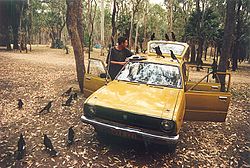
Over 180 bird species have been seen in the Gorge. These range from the tiny weebill (Smicrornis brevirostris) to the huge wedge-tailed eagle (Aquila audax). Some birds in the Gorge have become used to humans because people feed them. This is against Park rules. Park rangers are concerned because it causes some birds, like the laughing kookaburra (Dacelo novaeguineae) and the pied currawong (Strepera graculina), to have too many babies. When fewer visitors come in summer, these large bird populations put too much pressure on natural food sources. This can even include the young of other bird species.
You often see Australian bustards (Ardeotis australis) in the farmland near the Gorge. If it's been wet, you might also spot brolgas. Birds that live in groups, like the white-winged chough, the laughing kookaburra, and the apostlebird (Struthidea cinerea), are common near the entrance to Carnarvon Gorge.
Peregrine falcons (Falco peregrinus) and wedge-tailed eagles fly along the cliffs deeper in the Gorge. Below them, many parrots and honeyeaters search for food in the eucalypt trees. Closer to the ground, visitors are likely to see the Australian raven (Corvus coronoides) and the pied currawong anywhere they stop to eat. Along the walking tracks, many smaller birds live in the ground cover, including red-browed finches (Neochmia temporalis), white-browed scrubwrens (Sericornis frontalis), and several types of thornbills.
Reptiles and Amphibians
More than 90 reptile species and 22 frog species live in the National Park. The most common snakes in the Gorge are the keelback (Tropidonophis mairii), the green tree snake (Dendrelaphis punctulata), and the carpet python (Morelia spilota). The largest lizards are the lace monitor (Varanus varius) and the sand monitor (Varanus gouldii). Among the many types of skinks, the major skink (Egernia major) is the largest and found in a separate group here.
The frogs you'll most often see are the tusked frog (Adelotus brevis), the striped marsh frog (Limnodynastes peronii), and the cane toad (Bufo Marinus). The introduced cane toad is thought to be causing the local disappearance of the northern quoll (Dasyurus Hallucatus). Freshwater turtles, like Kreffts river turtle (Emydura krefftii) and the saw-shelled turtle (Elseya latisternum), are plentiful in Carnarvon Creek. You can often see them basking on rocks and logs during the day.
Invertebrates
The National Park has a huge variety of invertebrates (animals without backbones). Several insect species live only within the Park's boundaries. At least four types of land snails also live nowhere else. Butterflies are a special part of Carnarvon Gorge's animal life. Large groups of common crow (Euploea core) butterflies gather in the cool, moist side gorges to spend the winter.
Carnarvon Creek is also home to many invertebrates. Many of these are the young stages of winged insects like dragonflies. Visitors to Wards Canyon can easily watch these creatures in the clear, shallow, spring-fed stream.
Services and Facilities
The Queensland Parks and Wildlife Service (QPWS) has a base at Carnarvon Gorge next to the National Park Visitor Centre. The Visitor Centre is open every day from 8 AM to 4 PM and offers free Wi-Fi. The Carnarvon Gorge Day Use Area has picnic tables, toilets, and parking for cars, motorhomes, and caravans.
The Carnarvon Gorge Camping Area is only open during the Easter, Winter, and Spring Queensland School Holiday Periods. The Big Bend Camping Area is open all year. You can find different types of places to stay, including cabins, caravan and motorhome sites, and camping spots. Commercial tours of the gorge are also available.


